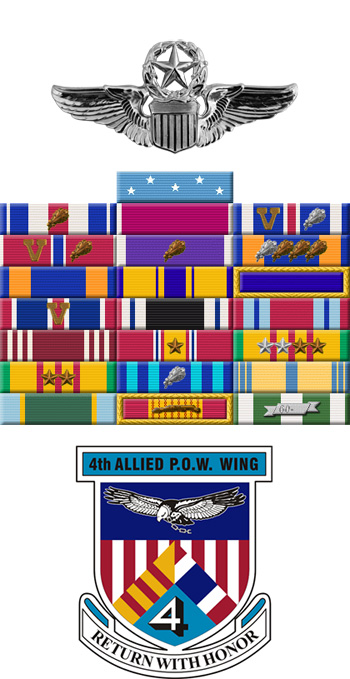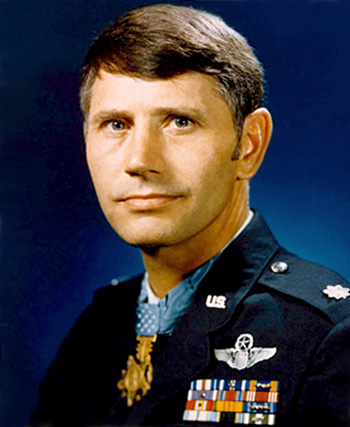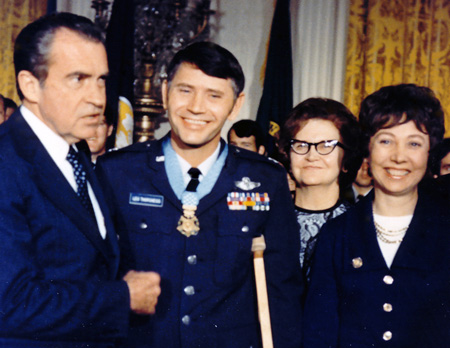
|
Leo K. Thorsness |
 |
|||
| Rank, Service | ||||
Colonel O-6, U.S. Air Force |
||||
| Veteran of: | ||||
|
||||
| Tribute: | ||||
Leo Thorsness was born on February 14, 1932, in Walnut Grove, Minnesota. Thorsness enlisted in the U.S. Air Force on January 5, 1951, and entered the Aviation Cadet Program of the Air Force in January 1953. He was commissioned a 2d Lt and awarded his pilot wings in April 1954. Lt Thorsness flew fighters for Strategic Air Command and Tactical Air Command before flying combat missions in Vietnam. He flew 92 and a half Wild Weasel missions in the F-105 Thunderchief and was shot down over North Vietnam and taken as a Prisoner of War on April 30, 1967, just 11 days after a mission for which he would later be awarded the Medal of Honor. Col Thorsness was also credited with shooting down one enemy fighter and one probable on that same mission. After spending 2,135 days in captivity, Col Thorsness was released during Operation Homecoming on March 4, 1973. He retired from the Air Force on October 24, 1973. Col Thorsness is a command pilot with 5,000 flying hours in L-21, T-6 Texan, T-28 Trojan, T-33, F-84B and D Thunderjet, F-84F Thunderstreak, F-100C and D Super Sabre, and F-105B, D, and F Thunderchief aircraft. Leo Thorsness served as a Washington State Senator from 1988 to 1992. He met Gaylee Anderson the first day of college and they were married in 1953 and have one daughter, Dawn, and two granddaughters. Leo Thorsness Flew West on May 2, 2017, and was buried at Arlington National Cemetery. His Medal of Honor Citation reads: For conspicuous gallantry and intrepidity in action at the risk of his life above and beyond the call of duty. As pilot of an F- 105 aircraft, Lt. Col. Thorsness was on a surface-to-air missile suppression mission over North Vietnam. Lt. Col. Thorsness and his wingman attacked and silenced a surface-to-air missile site with air-to-ground missiles, and then destroyed a second surface-to-air missile site with bombs. In the attack on the second missile site, Lt. Col. Thorsness' wingman was shot down by intensive antiaircraft fire, and the 2 crewmembers abandoned their aircraft. Lt. Col. Thorsness circled the descending parachutes to keep the crewmembers in sight and relay their position to the Search and Rescue Center. During this maneuver, a MIG-17 was sighted in the area. Lt. Col. Thorsness immediately initiated an attack and destroyed the MIG. Because his aircraft was low on fuel, he was forced to depart the area in search of a tanker. Upon being advised that 2 helicopters were orbiting over the downed crew's position and that there were hostile MlGs in the area posing a serious threat to the helicopters, Lt. Col. Thorsness, despite his low fuel condition, decided to return alone through a hostile environment of surface-to-air missile and antiaircraft defenses to the downed crew's position. As he approached the area, he spotted 4 MIG-17 aircraft and immediately initiated an attack on the MlGs, damaging 1 and driving the others away from the rescue scene. When it became apparent that an aircraft in the area was critically low on fuel and the crew would have to abandon the aircraft unless they could reach a tanker, Lt. Col. Thorsness, although critically short on fuel himself, helped to avert further possible loss of life and a friendly aircraft by recovering at a forward operating base, thus allowing the aircraft in emergency fuel condition to refuel safely. Lt. Col. Thorsness' extraordinary heroism, self-sacrifice, and personal bravery involving conspicuous risk of life were in the highest traditions of the military service, and have reflected great credit upon himself and the U.S. Air Force. |
||||
|
||||


